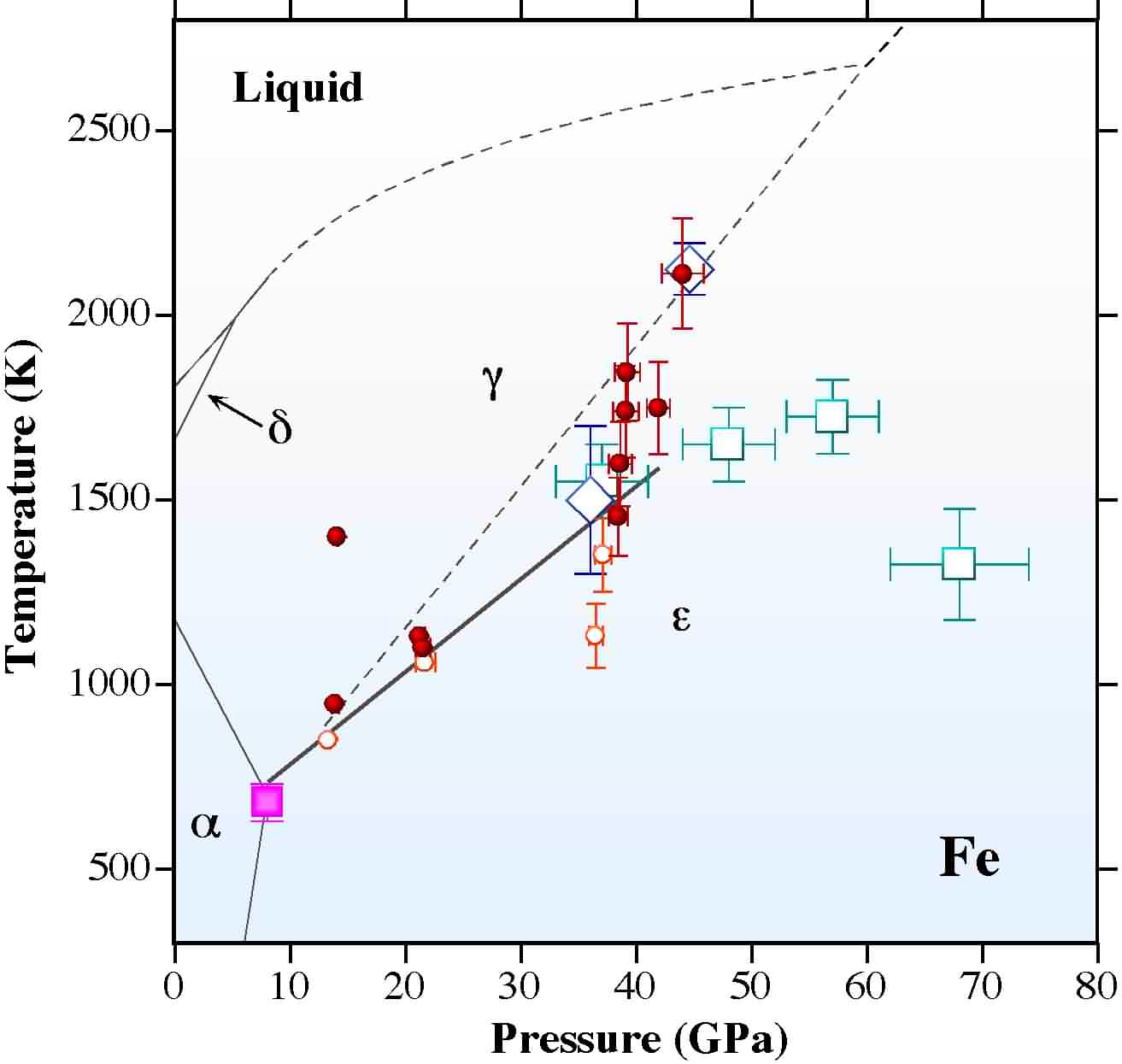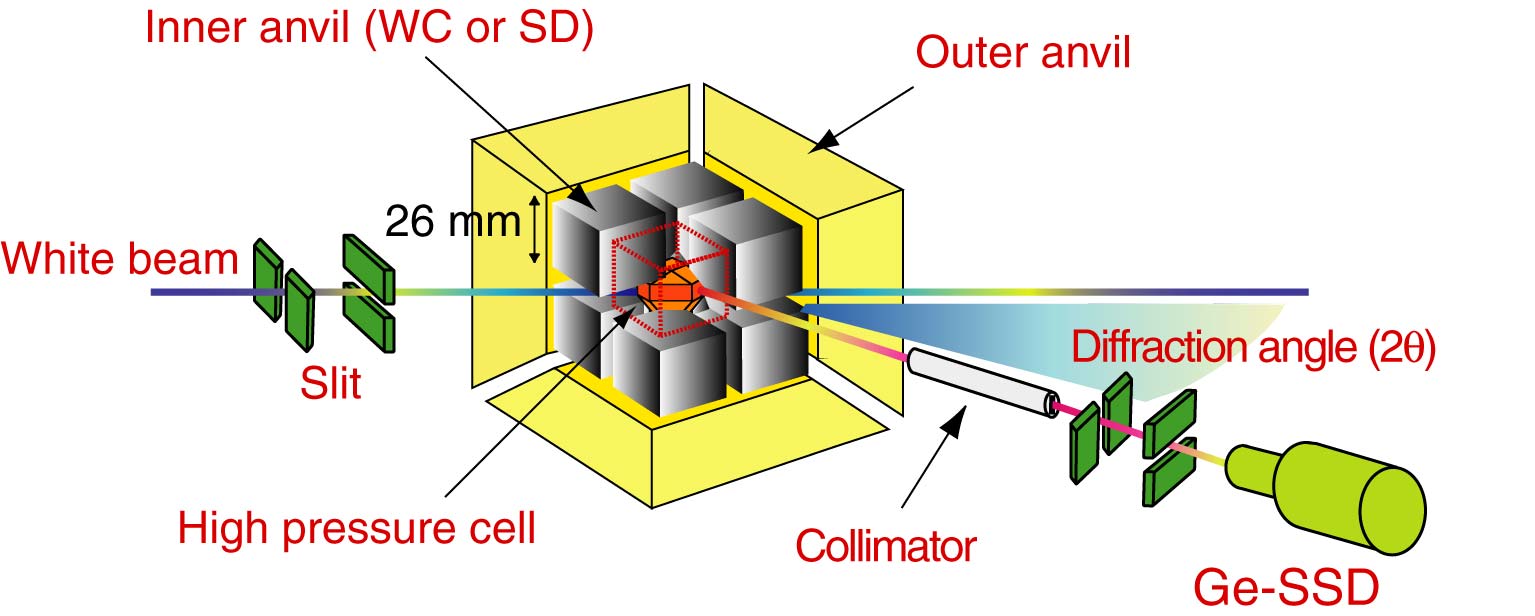High pressure experiment with sintered diamond anvils
問い合わせ番号
SOL-0000001176
ビームライン
BL04B1(高温高圧)
学術利用キーワード
| A. 試料 | 無機材料 |
|---|---|
| B. 試料詳細 | 金属・合金, 結晶 |
| C. 手法 | X線回折 |
| D. 手法の詳細 | 粉末結晶構造解析 |
| E. 付加的測定条件 | 高圧(大型プレス), 応力付加、変形, 高温(>>500度) |
| F. エネルギー領域 | X線(>40 keV) |
| G. 目的・欲しい情報 | 結晶構造, 構造変化, 相転移 |
産業利用キーワード
| 階層1 | 機械, 金属, 工業材料, その他 |
|---|---|
| 階層2 | 構造材(鉄、非鉄) |
| 階層3 | |
| 階層4 | 格子定数, 結晶構造, 結晶多形 |
| 階層5 | 回折 |
分類
A80.20 金属・構造材料, M10.20 粉末結晶回折
利用事例本文
The properties and states of iron at high-P/T have been extensively studied by Earth scientists, leading them to understand Earths inner core that is composed of iron. By the 1970s, four polymorphs of iron, namely phase (bcc), phase (fcc), phase (hcp), and phase (bcc) were known. In the 1990s, however, based on experiments using the diamond anvil cell (DAC), a fifth phase called phase (dhcp and orthorhombic) has been claimed to be present higher than 35 GPa and 1500 K. If the phase really does exist, we might replace -iron as the most likely phase to constitute Earths inner core with the phase. However, except for the DAC experiment, as the maximum attainable pressure is limited to less than 30 GPa, existence of the phase is controversial. It has become possible to generate higher pressures over 40 GPa at 2000 K, combining a large-volume press with the sintered diamond anvils and the energy-dispersive X-ray diffraction. Figure shows the phase boundary of iron determined by this study. Any phase but the and phases were not observed up to 44 GPa and 2100 K. The result suggests that the phase might be not a stable but metastable form, which is caused by the strong uniaxial stress on the sample using the DAC.
Fig. Phase boundary of iron determined by this study.
The open squares (dhcp) and diamonds (orthorhombic) are phases from the DAC experiments.
[ A. Kubo, E. Ito, T. Katsura, T. Shinmei, H. Yamada, O. Nishikawa, M.-S. Song and K. Funakoshi, Geophysical Research Letters 30, 1126 (2003), Fig. 3,
©2003 American Geophysical Union ]
画像ファイルの出典
所内報
誌名
Research Frontiers, 2001B-2002A
ページ
69
測定手法
An energy-dispersive X-ray diffraction system attached to the Kawai-type large-volume press is shown in figure. A white X-ray beam from the bending magnet light source is collimated with vertical and horizontal slits to form a thin beam possessing a cross section of typically 0.05 x 0.1 mm2. In order to carry out the energy-dispersive X-ray diffraction on the Kawai-type system, the first-stage anvils are cut holes to pass the X-ray beam. The incident white X-ray beam from the first-stage passes through the gaps between the second-stage anvils in a horizontal plane. X-rays diffracted by samples under high-pressure and high-temperature is detected by a pure Ge solid state detector (Ge-SSD) with a 4096 multi-channel analyzer. Diffraction data can be obtained with an energy range from 20 to 150 keV. Use of a collimator (0.05 mm width) and a receiving slit at a fixed angle to the direct beam permits only the diffracted X-rays from the sample to be detected. The horizontal goniometer covers a range of 2θ angles from -10 to 23° with an accuracy of 0.0001°. The X-ray acquisition time to obtain a diffraction profile is typically one to several minutes.
Fig. Schematic drawing of the energy-dispersive X-ray diffraction on the Kawai-type large-volume press.
画像ファイルの出典
BL評価レポート
ページ
14
測定準備に必要なおおよその時間
1 日
測定装置
| 装置名 | 目的 | 性能 |
|---|---|---|
| SPEED-Mk.II | High pressure and high temperature experiment | 2500 K, 50 GPa |
| SPEED-1500 | High pressure and high temperature experiment | 2500 K, 30 GPa |
参考文献
| 文献名 |
|---|
| Geophys. Res. Lett., 30, 1126(2003) |
関連する手法
アンケート
SPring-8だからできた測定。他の施設では不可能もしくは難しい
本ビームラインの主力装置を使っている
ユーザー持ち込み装置を使った
測定の難易度
熟練が必要
データ解析の難易度
中程度
図に示した全てのデータを取るのにかかったシフト数
10シフト以上


